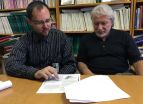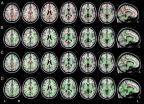(Press-News.org) An international team of researchers has for the first time predicted the occurrence of aurorae visible to the naked eye on a planet other than Earth.
Mars' upper atmosphere may be indeed closer to Earth's than previously thought. Researchers showed that the upper atmosphere of Mars glows blue depending on the activity of the Sun. The result was achieved through numerical simulation and a laboratory experiment, called the Planeterrella, used to simulate the aurora. The study was published in the leading planetology publication Planetary and Space Science on 26 May.
'The study indicates that the strongest colour in the Martian aurorae is deep blue. Green and red also occur, just like on Earth. An astronaut looking up while walking on the red Martian soil would be able, after intense solar eruptions, to see the phenomena with the naked eye', says researcher Cyril Simon Wedlund of Aalto University's Department of Radio Science and Engineering.
Prediction of multicolour aurora at Mars
The aurorae on Mars were observed for the first time in 2005 with the help of the European Space Agency ESA's Mars Express satellite. The new prediction is based on a laboratory experiment conducted with the Planeterrella simulator and a theoretical and numerical model developed by the Grenoble Institute of Planetology and Astrophysics (IPAG, France) and NASA.
'The Planeterrella experiment was conducted in France. We replicated the gas of the atmosphere with the most common component on Mars, which is carbon dioxide, after which an electrical discharge was created in a vacuum reminiscent of the Martian upper atmosphere, which led to the formation of a blue glow following the magnetic field structure', Simon Wedlund says, explaining the experiment.
The present study shows that, on Mars, aurorae also occur in the visible range. Aurorae occur when electrically charged particles of solar origin are driven down along the local magnetic field lines, where they enter the planetary atmosphere and excite its atoms and molecules. On Earth, aurorae are essentially green or red, from atomic oxygen, but even blue-purple, from ionized molecular nitrogen, can be seen.
Only 17 Planeterrellae simulators are currently in use in different parts of the world. Aalto University has developed the first Planeterrella simulator in the Nordic Countries, derived from the one used in this study but with a larger tribute to the historical Birkeland Terrella. The first laboratory experiments are to be conducted by the end of the year.
INFORMATION:
Link to the article http://www.sciencedirect.com/science/article/pii/S0032063315001300
Prediction of blue, red and green aurorae at Mars by J. Lilensten, D. Bernard, M. Barthélemy, G. Gronoff, C. Simon Wedlund, A. Opitz, Planetary and Space Science, May 2015, PII : S0032-0633(15)00130-0, DOI : 10.1016/j.pss.2015.04.015
Link to the pictures http://materialbank.aalto.fi:80/public/ea716ab1c838.aspx
Further information:
Researcher Cyril Simon Wedlund
cyril.simon.wedlund@aalto.fi
Tel. +358 50 4481 280
http://space.aalto.fi
http://planeterrella.osug.fr/?lang=en
GAINESVILLE, FL -- As the container nursery industry faces severe restrictions on water use, researchers are looking to identify ways to minimize watering needs and eliminate excess watering. The authors of a new study say that understanding container-grown plants' capacity to "capture" sprinkler irrigation water can give growers important tools that help them adjust irrigation rates, reduce water use, and produce healthy plants.
Jeff Million and Thomas Yeager from the Department of Environmental Horticulture at the University of Florida say that there has been limited ...
Brisbane flood victims suffered more psychological distress during the rebuilding phase than as waters inundated their homes and businesses, a Queensland University of Technology study has found.
Kelly Dixon, from QUT's School of Psychology and Counselling, has looked at the mental health impacts caused by the Brisbane 2011 and the Mackay 2008 flood disasters.
"The findings showed that aftermath stress contributed to poor mental health outcomes over and above the flood itself, prior mental health issues and demographic factors," Ms Dixon said.
Presenting her findings ...
In a groundbreaking study published recently in the Journal Psychology, Professor Lea Waters from the Melbourne Graduate School of Education outlines how children can draw on their personal strengths to cope with the demands that lead to stress.
"While some stress such as toxic stress caused by a long lasting intense negative experience can have a debilitating effect on the wellbeing of children, not all stress is bad or damaging," Professor Waters said.
"Positive stress is a normal part of the developmental process. When managed well, it has the potential to help children ...
Warring armies use a variety of tactics as they struggle to gain the upper hand. Among their tricks is to attack with a decoy force that occupies the defenders while an unseen force launches a separate attack that the defenders fail to notice.
A study published earlier this month in the journal Proceedings of the National Academy of Sciences suggests that the Hepatitis C virus (HCV) may employ similar tactics to distract the body's natural defenses. After infecting patients, Hepatitis C evolves many variants, among them an "altruistic" group of viral particles that appears ...
Millions of genetic variants have been discovered over the last 25 years, but interpreting the clinical impact of the differences in a person's genome remains a major bottleneck in genomic medicine. In a paper published in The New England Journal of Medicine on May 27, a consortium including investigators from Brigham and Women's Hospital (BWH) and Partners HealthCare present ClinGen, a program to evaluate the clinical relevance of genetic variants for use in precision medicine and research.
"We're dealing with massive amounts of information: more than 80 million genetic ...
Tremendous advances have been made in decoding the human genome in recent years but critical questions remain regarding what these variants mean and how they can be applied in clinical practice. In a comprehensive paper to be published in The New England Journal of Medicine on May 27, 2015, "ClinGen: The Clinical Genome Resource," a consortium including investigators from the American College of Medical Genetics and Genomics (ACMG) provide a detailed overview of ClinGen, an NIH-supported program to evaluate the clinical relevance of genetic variants for use in precision ...
Women who eat a Mediterranean diet could cut their risk of womb cancer by more than half (57 per cent), according to a study published today (Wednesday) in the British Journal of Cancer*.
The Italian researchers looked at the diets of over 5,000 Italian women to see how closely they stuck to a Mediterranean diet and whether they went on to develop womb cancer**.
The team broke the Mediterranean diet down into nine different components and measured how closely women stuck to them. The diet includes eating lots of vegetables, fruits and nuts, pulses, cereals and potatoes, ...
If greenhouse-gas emissions continue to rise, glaciers in the Everest region of the Himalayas could experience dramatic change in the decades to come. A team of researchers in Nepal, France and the Netherlands have found Everest glaciers could be very sensitive to future warming, and that sustained ice loss through the 21st century is likely. The research is published today (27 May) in The Cryosphere, an open access journal of the European Geosciences Union (EGU).
"The signal of future glacier change in the region is clear: continued and possibly accelerated mass loss ...
The psychological strain of being told that you may have breast cancer may be severe, even if it turns out later to be a false alarm. This is the finding of new research from the University of Copenhagen, which has just been published in the scientific journal Annals of Family Medicine. Researchers call for improving screening accuracy, thus reducing the number of false-positive mammograms.
It was a false alarm. You don't have breast cancer. This ought to be a happy message for women who have been through a mammography screening which initially showed signs of something ...
OAK BROOK, Ill. - Degeneration of the white matter of the brain may be an early marker of specific types of Alzheimer's disease (AD), including early-onset AD, according to results of a new study published in the journal Radiology.
"Alzheimer's is a gray matter disease," said Federica Agosta, M.D., Ph.D., co-author of the study conducted at the Neuroimaging Research Unit, San Raffaele Scientific Institute in Milan, Italy. "However, white matter damage has a central role in how the disease strikes and progresses."
AD is an irreversible, progressive brain disease that ...



